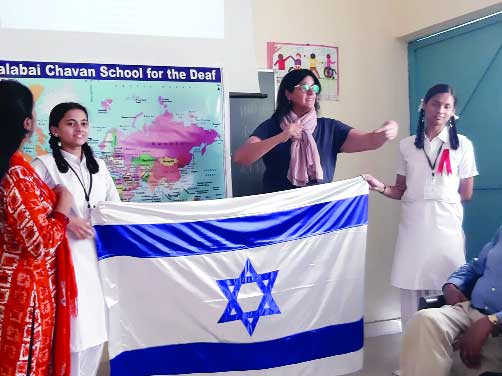Israeli sign language teacher Navit Hagar Malachi lists some innovative teaching methods for deaf children and emphasizes upon the lack of proper studying material in Indian schools. By Chahak Mittal
Saturday, 31 August 2019
Chahak Mittal
the pioneer
The significance of hearing often goes unrecognised and under-appreciated until it’s no longer available. And for those who have been born like that and lived their lives in silence, education might prove to be a challenge. While many theories have emerged over the years as to what approach could be the most effective, experts say that the teaching methods should adhere to the individual student’s capabilities, needs and personality.
Navit Hagar Malachi, an Israeli teacher of sign language, who, being deaf herself, belongs to the special education team, believes so too. She had recently travelled to the city and conducted different activities for young deaf children at Promilabai Chavan School for the Deaf, Karkardooma and Noida Deaf Society. She feels that such students should be provided “after-school enrichment classes,” which do not appear as boring classes to them and rather make them “want” to be a part of it.
Giving a reference from Israel and talking about the differences between Israeli teaching methods and that of India, she says, “There are organisations that hold activities and provide enrichment after graduation for deaf or hard of hearing children. Once in a week, every child chooses her/his favourite activity and learn and develop it in depth. Whether it be sports, theatre, lessons for students with learning difficulties, nature activities and more, everything is available and children are free to pick up their field of interests. We should apply this to schools for deaf in India as well for the extra nourishment of these students.”
It’s very surprising that most children are not even diagnosed as hearing-impaired until they are three to five years ago. Malachi suggests that this should be checked upon during a child’s early years of growth to avoid a delayed education and conditioning. She suggests other learning approaches like day schools, early intervention and pre-school programs, residential schools for the deaf, self-contained classrooms, mainstreaming and inclusion in general education settings and home-schooling environment.
Knowledge is power and when presented visually, one remembers it, or so she believes and suggests that it is very important to put up the learning material on the walls of the classrooms and make them more interactive. “The walls should specify the names of the subjects which are to be studied and beneath them, the material and syllabus should be mentioned. For instance, formula in mathematics should be written on the walls to avoid confusion. It will help the students remember the topics which are being taught. A world map must be put up on the classroom walls,” she says and recalls one of her major observations in Indian schools. “In almost every school I visited, there was no world map on the walls. The students did not know where can we spot Israel on the world map,” she adds.
Malachi, who is the chairman of the Hushim (Senses) Association, a non-profit organisation for the Jewish community in Israel, talks about her approach of teaching the differently-abled children. She says, “First, the text is introduced to the students. I move and read along with them with emphasis on hard words or new words and then ask questions from it. This way they keep practising. Eventually, the students write the text in their own words.”
It was at a time when she was looking for a job that the opportunity to work with the Hushim Association came to her. “I decided to work for deaf children when I felt that I had done enough to empower myself in the world of hearing and now I could invest the same for other people of my own kind,” says she. Well, if her teaching strategies succeed and the kids are able to understand and learn a new and challenging thing, for her, it’s an achievement and she feels that she has been able to “help someone.”
The organisation, Hushim Ben Dan, she says, is actually a Chabad (a term for Jewish movements) for the deaf. She tells us, “It builds international connections with Jewish communities and deals with making Judaism accessible to the deaf. “It holds activities like summer camps, vacations and trips in the country on the emphasis of Judaism, synagogue, Torah lessons, workshops and everything that is accessible in the Israeli sign language.”
Many schools for deaf students are also adopting modern teaching techniques like using interpreters for easier translation of the learning material as well using advanced tools for enhanced auditory abilities. Malachi suggests, “Experience sharing with the educational team for recommendations and ideas of techniques. One can also teach through the Ministry of Education in Israel, programmes and educational websites that hold games and presentations.”
Source: www.dailypioneer.com/2019/vivacity/hearing-the-unsaid.html





